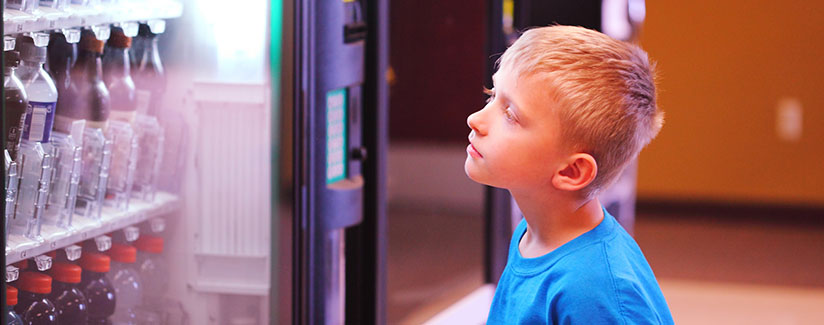
Smarter Snacking at School: New Standards for Vending Machines
The USDA’s new Smart Snacks in School nutrition standards attempt to balance science-based nutrition guidelines with practical and flexible solutions to promote healthier eating for students. The proposed standards were introduced earlier this summer and are scheduled to take effect for the 2014-2015 school year. Are the standards reasonable? How will students react to them? We went to Lauren Headrick of the University of Florida, a registered dietitian and statewide coordinator of the Florida Farm to School program, for some insight.
What’s the reasoning behind these new snacking standards for schools?
These standards align the snack items that will be available with the dietary restrictions already set for the National School Lunch and School Breakfast programs. Currently, there aren’t any rules or guidelines for snack foods sold in schools. This means that there are no limits on the calorie content of what’s offered. That said, some states have rules – for instance, in Florida, elementary schools have rules about when vending machines are available to the kids and what types of sodas or food items are offered.
With the new standards, snack foods are going to be much more nutrient-dense. For elementary and middle schools, the only drinks that will be offered are milk, water and 100 percent juices. Drinks containing caffeine, such as diet sodas, will be available in high schools, but there will be limits on how much sugar they can contain. In addition to focusing on nutrient density, the standards focus on eliminating drink and snack options that are high in sugar. As for salty snacks, sodium levels will be slowly reduced over the next few years. There will be limitations on the fat content, too.
Will these new rules be effective and how do you think students will react to the new snacks?
Actually, schools that are participating in the HealthierUS School Challenge program area already complying with these new standards. There’s an extensive list of snacks and drinks that schools can offer that meet the certification requirements. For instance, ice cream is on the list. It’s reduced fat ice cream, but it’s allowed. There are baked chips, reduced fat cookies and reduced-sugar fruit snacks as well. So, to me, there are plenty of options that will meet the nutrition requirements that can be substituted for less nutrient-dense alternatives that are currently offered.
We’re urging schools to begin offering these new items that will meet the new Smart Snacks standards and they can start gauging which ones sell and which ones don’t. Why wait until next year and having to revamp their entire competitive foods list?
Some are concerned that these new standards will cost local school districts money. What are your thoughts?
There is a worry that schools are going to have reduced sales – especially at the high school level. If they start changing now, I think they can get ahead of the game when these standards take effect in 2014. They can figure out ahead of time which snacks students find acceptable and which ones just will not sell. But kids are very adaptable. Schools might see a brief dip in the amount of money they’re making from the sales of some of these snack items but I think it will even back out over time.
In schools where these standards are already being adhered to, what has been the student reaction?
In my experience, younger kids tend to deal with it a little better. As an example, high school age students tend to get upset if you take away sports drinks. But, I think they will ultimately accept these new snacks standards as well. Another benefit is that I believe the food industry will also respond to the needs of the school districts and offer new items that will meet these standards.
Some students will bring what they want to eat from home, and others will simply leave campus to find the foods they’re used to eating. There’s no way around that. But I think if schools will be proactive and begin experimenting with some of these new items before the standards are mandatory, they can avoid some of the backlash that might accompany sudden implementation of the new rules. I think for most items that don’t meet the new standards, there will be an acceptable substitute that students will accept.

“Vending Machine” by Sharon & Nikki McCutcheon is licensed under CC BY.


























